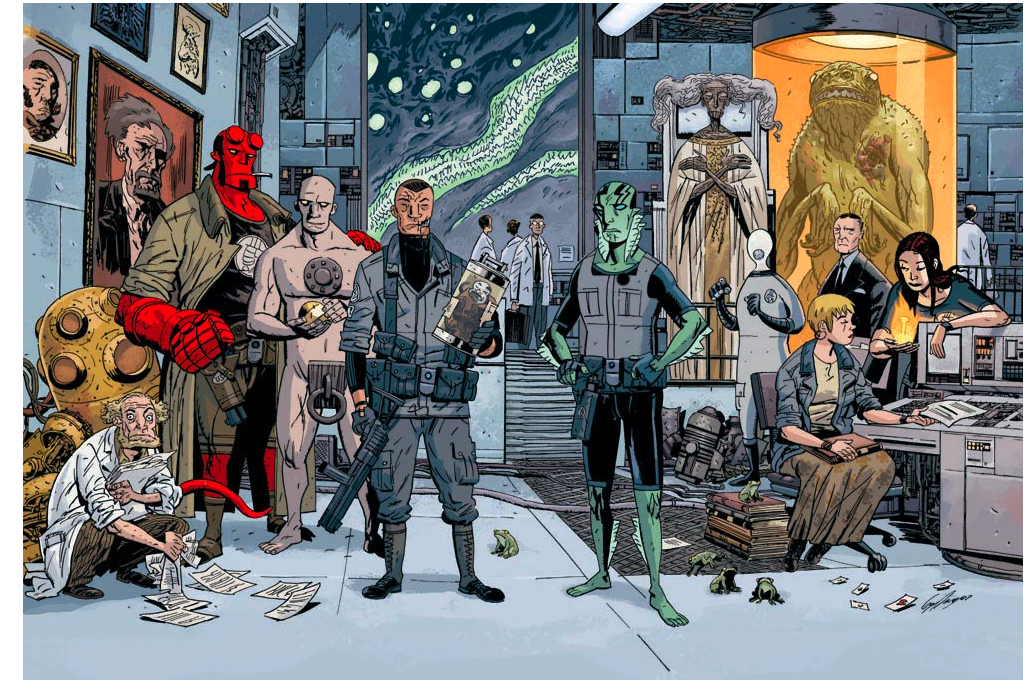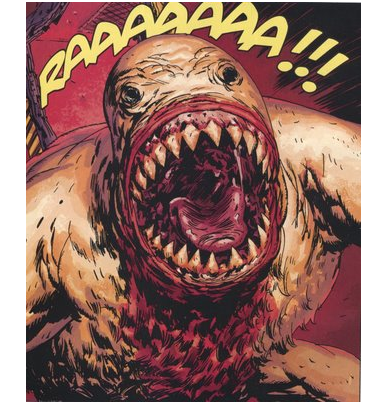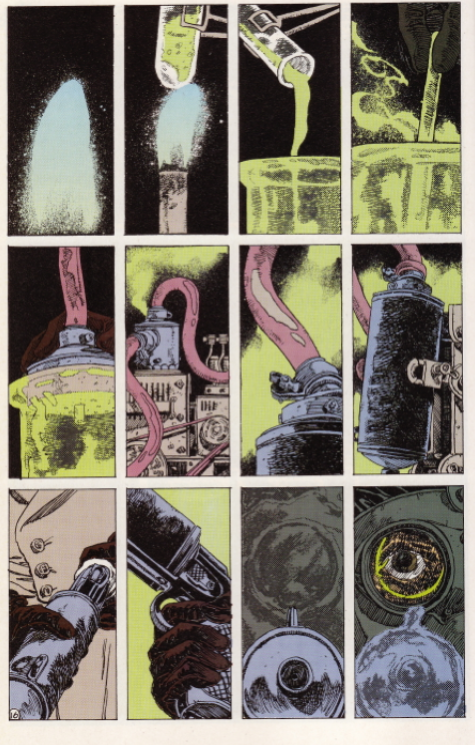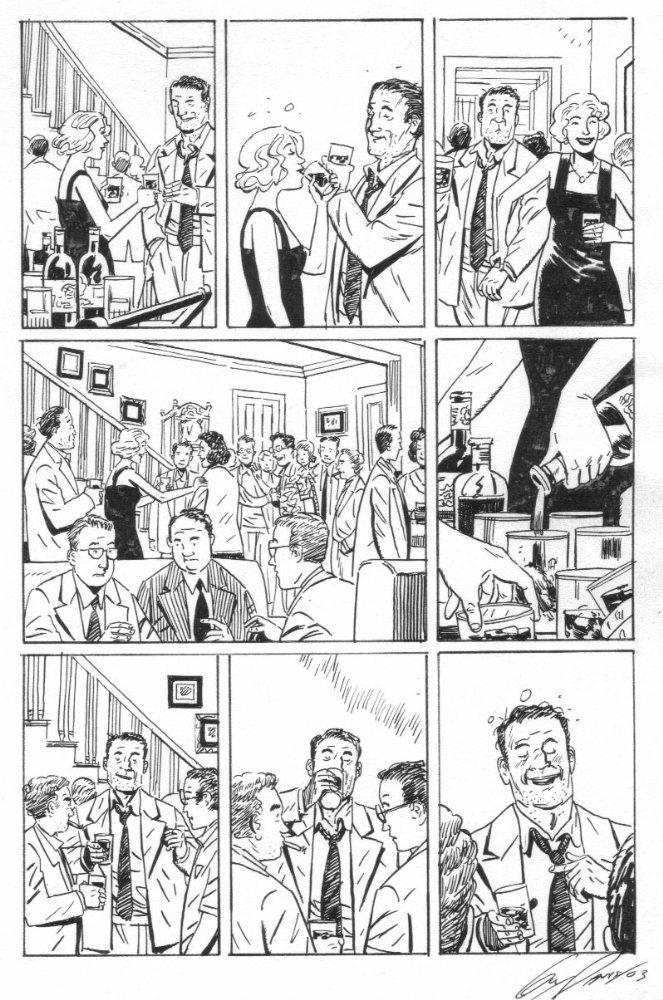 I didn’t get Guy Davis. Not immediately.
I didn’t get Guy Davis. Not immediately.
The first Hellboy film had just been released, and I was scouring every available avenue for more of that world. It’s how I returned to comics. Gradually but fervently, in obsessive bursts triggered by each consecutive movie adaptation. This round involved prying every scrap of Mignola knowledge from the internet’s toothy maw. The moment I’d learned of B.P.R.D.‘s existence as a sister series I knew I wanted in. But who was this clown drawing it? It looked nothing like Mignola’s bold, stained glass style. It was crude, I thought. Second banana. I avoided it in favor of other things. And so it would take a few more years before Guy Davis totally won me over.
I could smack myself.
Sitting here, today, looking over individual Guy Davis panels, I do find myself amazed. But then things have changed since I originally discovered the stuff. I’m not suggesting that you have to decode Guy Davis or go backpacking across Europe to fully appreciate his technique. All you really have to do is read it. Actually read it and not simply stare at it. In comic art, it’s not so much about each frame, but the combination of frames. Context comes with movement. Progression. I think that gets lost in the shuffle sometimes. We often evaluate sequential art under the same lens as, say, a cover. These two elements serve radically different functions and actually shouldn’t look so similar (in execution, if not style). The most obvious distinctions are detail and rendering. While a finely rendered panel or splash is undeniably thrilling, the interior pages of a comic really don’t require the same level of visual complexity as the book’s exterior. Call it economy, but it’s not just a question of compromise. It’s a matter of storytelling. The same can be said of screenwriting, where minimalism is valued over lofty prose. The highest accomplishment is a transparent read. Readers should feel like they’re experiencing the drama and not simply reading it. Anything which distracts from that is superficial and ought to be cut.
This all came together for me while listening to our own Talksplode interview with Eric Canete. Eric talked about his understanding that panel progression relies more on energy than meticulous detail. If every element within the image is equally detailed, the panel — while gorgeous on its own — lacks emphasis. Readers get hung up on the details, which stunts the momentum of the story. Personally, I experienced this problem with Kingdom Come. Individually, Alex Ross’ panels are absolutely arresting. As a whole, the book lacked the energy of sequential movement. All percussion. So, despite Ross’ grandeur and masterful talent as a fine artist, I’d ultimately rather have Davis drawing my interiors.
So, what is it about Davis then? I’ll still admit that it’s sort of crude. It’s messy. There are times when it’s downright hideous. But above all else, it’s visceral. Visceral in a way that other popular comic book artists, for all their talent, can’t be. Guy Davis draws dangerously. Despite his hyperbolic style which tends to thumb its nose at traditional, anatomical precision, Davis’ characters actually feel more alive. It’s the kind of feral and aggressive line work that lends an organic quality to his monsters. His Wendigo character in B.P.R.D. is intensely creepy, but also haunting. Haunting in the sense that the character’s tragic back story really stuck with me for days after reading. It’s a tribute to John Arcudi’s script, but also Davis’ totally horrific, totally human monster design.

If you read up on Will Eisner, you come across this concept of cartooning. For Eisner, one of the true greats, it meant the difference between someone who simply draws and a master of the form who tells a story with pictures. While many talented comic artists are tremendous illustrators, visually translating a writer’s script, few of them are honest to god cartoonists. Often, you find them in the independent comics world, both writing and drawing their own stories. But I’ve read enough Guy Davis projects to know that he’s the real deal. It’s difficult to discern how much influence the writer has on the artist’s output, how much specific direction he or she dictates. But in each book Guy Davis has produced, regardless of the writer involved, his images transcend illustration. He’s a storyteller, and a damned good one. I’m astonished in B.P.R.D. specifically, where he manages to convey so much with a character who essentially has a fishbowl for a head. Simple curves or pressure changes in a line and Johann Kraus is either furious or suspicious or profoundly sad. Without so much as a mouth.
This week I’ve been reading some of his older work. Sandman Mystery Theatre, where have you been all my life? Davis reminds me of From Hell here, with big, solid figures and stray pencils all over the place. It’s a terrific pulp story from Matt Wagner, and it got me where I live. This smoke and daggers stuff is my bread and butter. It also proves that Davis can render with the best of them. The line work here is beautiful with old world shading and modeling. It serves the story and it doesn’t distract. And, you want to talk about grids…
Unstable Molecules by James Sturm is a strange and wonderful human drama about real people who, in their own tragic way, mirror (perhaps, inspire?) the relationships of the iconic Fantastic Four. I compare it to Brian K. Vaughan’s The Escapists, but that’s still a ways off. It’s a difficult book to describe, but I really do want to recommend it. It’s shelved with the other Fantastic Four trades at my shop, but it doesn’t feel like any Marvel book I’ve ever read. It scratched the same itch as Kavalier and Clay, but there’s even a bit of Craig Thompson and Tintin in there. It feels older than its 2005 publication. Guy Davis is a little more refined here, but that only serves to strengthen his human expressions. Even without the word balloons, just look at the storytelling in that page (which I tried to buy a few weeks back; the seller told me he couldn’t find it.).
It kills me that this book isn’t as popular as it ought to be. While not strictly a Fantastic Four story, it felt to me like the Batman: Year One of that title.
I didn’t get Guy Davis at first. Not immediately. I’ve figured it out since. And in doing so, I learned a hell of a lot about comics and how they work.
Paul Montgomery is just a fuzzy cluster of molecules. Contact him at paul@ifanboy.com. You can also find him on Twitter.




I am so ga-ga over Guy Davis, it’s almost embarassing. Another thing of his that should be checked out is his creator owned project The Marquis (there are two trades), and also he did the art for the European comic The Zombies That Ate The World which is currently be reprinted by DDP I believe…
I almost took this to e-mail, because I don’t know if I can take it if yet another thing becomes All About Watchmen this week.
But!
I was very intrigued by this passage in particular:
"Eric talked about his understanding that panel progression relies more on energy than meticulous detail. If every element within the image is equally detailed, the panel–while gorgeous on its own–lacks emphasis. Readers get hung up on the details, which stunts the momentum of the story."
Given this theory– which strikes me as a good one– what do you make of Alan Moore’s 100-page behemoth scripts that intricately detail every square milimeter of the panel in a way that would make Howard Hughes say, "Yikes! Relax, buddy"? Does that approach to writing ultimately hinder the storytelling once the writer is saddled with it? Are we as readers/viewers, in fact, hung up on the details as a result? Is that what all the palaver has ultimately been about all week?
Also: Unstable Molecules is great. I wish we saw more books like it out of Marvel these days.
Unstable Molecules is fantastic and vastly underrated. Sandman Mystery Theatre is a fantastic series. One of the first I started "double-dipping." I own the individual issues, but last summer I started buying the trades from the half-off trades booths at Comicon because I really wanted to re-read the series and have it on my bookshelf.
Also: You should also check out Davis’ series The Marquis. I think either Oni or Dark Horse have it. He actually wrote and drew that. And I’m not sure if this is still in print anywhere, but my first exposure to Guy Davis was through Baker Street, an alt history sherlock-holmes-meets-punk type thing.
@Jimski Bless you for posting it as a question. Now I can innterupt and offer a few thoughts. Moore is a man of somewhat singular vision. I’ve always taken his work as his and his alone. He clearly respects and appreciates his artists as collaborators and I have no doubt that he views them with as equal partners. However, his artists have always struck me as means to an end, i.e. his vision.
I don’t think it is a result of his scrips that comic readers or readers in general have become detail orientted. Anlysis, evaluation, deconscrution are the finer levels of enjoyment in art. Once the Euphoria of exxperience has worn off, we ask "Why do I like this?" And spend time in deconstruction. Moore style allows this because his obssesiveness affirms the old adage that form follows function.
I love SMT, and am glad that Vertigo has slowly been releasing the trades.
The line to dogpile on DaveCarr for referring to Gibbons, Williams, Bolland, etc. as "a means to an end" forms to the right. 😉
@Jimski – It’s a good question. Perhaps I need to revise my argument slightly. Detail does halt momentum, but that’s not always a bad thing. We read Moore’s comics slowly because he wants us to. He’s designed them so meticulously because he wants us to take our time. This isn’t always the intention of detailed comics though. Action adventure stories tend to read a little faster. So if we’re reading a chase scene, the velocity of the movement is paramount while the furnishing might not be. There are certainly cases where detail is crucial. All I’m saying in this piece (in reflection of Canete’s comments) is that, more often than not, dynamic action and minimalist storytelling are more important than meticulous architectural or anatomical detail. What generally matters is movement.
@profdresser – I totally forgot about Zombies That Ate the World! I bought the first issue and loved it. Nobody does better zombies/corpses. Nobody.
@daccampo – The Marquis and Baker Street are definitely on my list. Just gotta put a hurtin’ on this huge stack of trades. (Says the man who just picked up Young Liars vol. 1 not two hours ago..)
I’ll second the recomendation for ‘The Marquis’.
Just for clarity’s sake, I’ll like to say that all of the artists Moore has worked with are superblly talented storytellers and creators , I just don’t know, and this opinion is based purely on those scripts that Jimski mentioned and the impression I’ve gotten from interviews with Alan,) that these artists had much influence on the content of those scripted ideas. I will say that Lost Girls seems to be the exception ruke there. There something different about the book perhaps because it is so explicitly cisiual that always made me feel a synergy.
Anyway, this about Alan Grant, not Alan Moore so I will say that "Unstable molecules intrigues me". A lot. Seems like it’s in the same vein as Superman Secret identity., etc. I love the muted psychedlic coloring on the panel you chose, Paul.
Sandman Mystery Threatre is great stuff.
Guy Davis is one of my absolute favorites. Baker Street was the first "Adult" comic I read when I was 15 and squatting in a punk house. I even did my hair like Sam for a few years. It makes me happy that he is getting more praise, although still not as much as I think he deserves! I really need to catch up on the BPRD stuff now…
That is gorgeous art indeed.
So a movie got you back into comics eh? *needle*
@jumpingjupiter – Movies like Hellboy and X-Men got me to buy trades. A tonsillectomy and iFanboy’s Pick of the Week podcast got me reading comics weekly.
You make it sound like the iFanhosts tortured you on the podcast to get you to read comics…
That’s what I tell the lady at H&R Block.
zing!
Guy Davis is a storytelling monster. That guy can put a page together!
I’ve only read the Sandman Mystery Theatre he did. I can see I have more titles to add to my shopping list… eep
Sandman Mystery Theatre deserves much love. that character design is just amazing!
Great artist, and one of the nicest guys out there. Seriously, next time you see him, tell him I told you so. He’ll chuckle and say something that takes the focus off of him. He deserves a spotlight!
This is a really well thought out and insightful article. It gave me a lot to think about and I can’t wait to get home and look at my BRPD trades again. Thanks for posting this!
I’ve read BPRD off and on, and I love Davis’s work. I’ve also had a copy of ‘Unstable Molecules’ since the Baltimore Con last fall and haven’t cracked it, despite hearing nothing but wonderful recommendations. I didn’t know it was Guy Davis, though, that might be the motivation I need (I might have, uhh, thought it was Alan Davis when I picked it up, not that that’s a bad thing either).
i love that bprd picture up there. he is amazing and makes me love bprd
For all you Davis fans out there, he’s the subject of Two Morrows great series of books Modern Masters in the very near future…they’re a great set of books, I can’t recommend them enough!